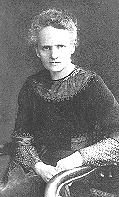Marie Sklodowska Curie
(1867-1934)
Tribute To Greatness
 Marie and Pierre Curie devoted their lives to moving forward the frontiers of science. They shared the 1903 Nobel Prize for Physics with Henri Becquerel and were honored for their joint research on radiation phenomena. Marie Curie proved with her research that radioactivity is an atomic property and, in 1911,
received her second Nobel Prize, this time in chemistry, for the discovery of polonium and radium, the isolation of radium and the study of its nature and compounds.
Marie and Pierre Curie devoted their lives to moving forward the frontiers of science. They shared the 1903 Nobel Prize for Physics with Henri Becquerel and were honored for their joint research on radiation phenomena. Marie Curie proved with her research that radioactivity is an atomic property and, in 1911,
received her second Nobel Prize, this time in chemistry, for the discovery of polonium and radium, the isolation of radium and the study of its nature and compounds.
The ultimate impact of these pure research discoveries has been profound and personal for the millions of people who have since undergone radiation treatment for cancer.
In World War I, Marie Curie personally organized the installation and training of X-ray and radiation therapy services for the military hospitals in France and Belgium. This work was directly responsible for saving many lives and lessening the suffering and infirmity of many wounded men.
In her Radium Institute, she was a mentor for all the researchers, especially women, and became a role model for women all over the world.
As a wife and mother, Marie Curie touched her family with love and devotion, as a scientist she touched the world and opened a new window on the universe.
also
Marie grew up in a family that valued education. As a young woman she went to Paris to study mathematics, chemistry and physics. She began studying at the Sorbonne in 1891, and was the first woman to teach there. She adopted the French spelling of her name (Marie) and also met Pierre Curie, who taught physics at University of Paris. Marie and Pierre soon married, and teamed up to conduct research on radioactive substances. They found that the uranium ore, or pitchblende, contained much more radioactivity than could be explained solely by the uranium content.
The Curie’s began a search for the source of the radioactivity and discovered two highly radioactive elements, “radium” and “polonium.” The Curie's won the 1903 Nobel prize for physics for their discovery. They shared the award with another French physicist, Antoine Henri Bacquerel, who had discovered natural radioactivity. In 1906 Pierre, overworked and weakened by his prolonged exposure to radiation, died when he was run over by a horse drawn wagon.
Madame Curie continued her work on radioactive elements and won the 1911 Nobel prize for chemistry for isolating radium and studying its chemical properties. In 1914 she helped found the Radium Institute in Paris, and was the Institute's first director. When the first world war broke out, Madame Curie thought X-rays would help to locate bullets and facilitate surgery. It was also important not to move the wounded, so she invented X-ray vans and trained 150 female attendants.
On July 4, 1934, at the age of 67 Madame Curie died of leukemia (aplastic pernicious anemia), thought to have been brought on by exposure to the high levels of radiation involved in her research. After her death the Radium Institute was rename the Curie Institute in her honor.
.
.
.
[WIC Main Page || Biographies]